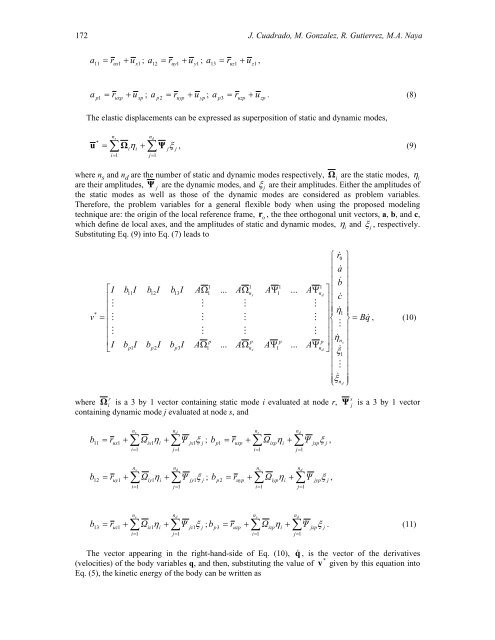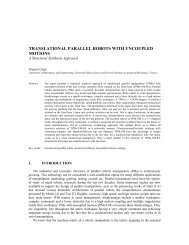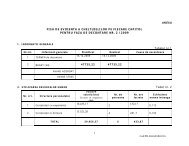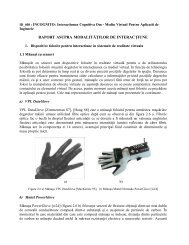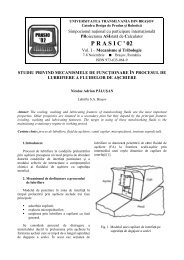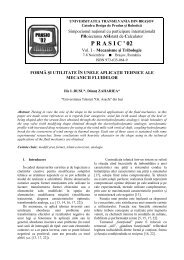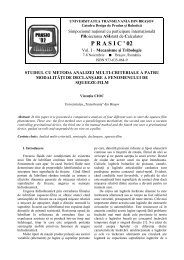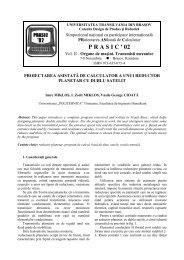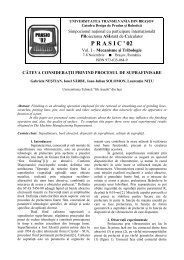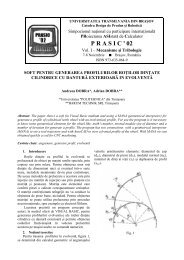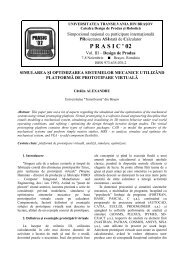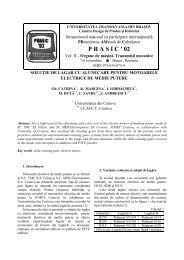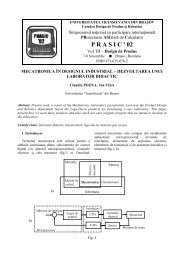real-time mbs formulations: towards virtual engineering
real-time mbs formulations: towards virtual engineering
real-time mbs formulations: towards virtual engineering
You also want an ePaper? Increase the reach of your titles
YUMPU automatically turns print PDFs into web optimized ePapers that Google loves.
172 J. Cuadrado, M. Gonzalez, R. Gutierrez, M.A. Naya<br />
a<br />
11<br />
= r ux 1<br />
+ u<br />
x1<br />
; a<br />
12<br />
= r uy 1<br />
+ u<br />
y1<br />
; a<br />
13<br />
= r uz 1<br />
+ u<br />
z1<br />
,<br />
a = r + u<br />
a = r + u<br />
p1 uxp xp<br />
;<br />
p2 uyp yp<br />
;<br />
p uzp zp<br />
a<br />
3<br />
= r + u . (8)<br />
The elastic displacements can be expressed as superposition of static and dynamic modes,<br />
ns<br />
∑<br />
i=<br />
1<br />
i<br />
i<br />
nd<br />
∑<br />
*<br />
u = Ω η + Ψ ξ , (9)<br />
j=<br />
1<br />
j<br />
j<br />
where n s and n d are the number of static and dynamic modes respectively, Ω<br />
i<br />
are the static modes, η i<br />
are their amplitudes, Ψ<br />
j<br />
are the dynamic modes, and ξ j<br />
are their amplitudes. Either the amplitudes of<br />
the static modes as well as those of the dynamic modes are considered as problem variables.<br />
Therefore, the problem variables for a general flexible body when using the proposed modeling<br />
technique are: the origin of the local reference frame, r<br />
o<br />
, the thee orthogonal unit vectors, a, b, and c,<br />
which define de local axes, and the amplitudes of static and dynamic modes, η i<br />
and ξ j<br />
, respectively.<br />
Substituting Eq. (9) into Eq. (7) leads to<br />
v<br />
*<br />
⎡I<br />
⎢<br />
⎢M<br />
= ⎢M<br />
⎢<br />
⎢M<br />
⎢<br />
⎣<br />
I<br />
b<br />
b<br />
11<br />
I<br />
p1<br />
I<br />
b<br />
b<br />
12<br />
I<br />
p2<br />
I<br />
b<br />
b<br />
13<br />
I<br />
p3<br />
I<br />
AΩ<br />
M<br />
M<br />
M<br />
AΩ<br />
1<br />
1<br />
p<br />
1<br />
...<br />
...<br />
AΩ<br />
M<br />
M<br />
M<br />
AΩ<br />
1<br />
ns<br />
p<br />
ns<br />
AΨ<br />
AΨ<br />
1<br />
1<br />
p<br />
1<br />
...<br />
...<br />
AΨ<br />
M<br />
M<br />
M<br />
AΨ<br />
1<br />
nd<br />
p<br />
nd<br />
⎧ r&<br />
0 ⎫<br />
⎪<br />
a&<br />
⎪<br />
⎪ ⎪<br />
⎪ b&<br />
⎪<br />
⎤⎪<br />
⎪<br />
⎥⎪<br />
c&<br />
⎪<br />
⎥<br />
⎪ & η<br />
⎪<br />
1<br />
⎥⎨<br />
⎬ = Bq&<br />
, (10)<br />
⎥⎪<br />
M<br />
⎪<br />
⎥⎪<br />
& η ⎪<br />
⎥<br />
ns<br />
⎦⎪<br />
& ⎪<br />
⎪ ξ1<br />
⎪<br />
⎪ M ⎪<br />
⎪<br />
&<br />
⎪<br />
⎪⎩<br />
ξn<br />
⎪<br />
d ⎭<br />
r<br />
where Ω<br />
i<br />
is a 3 by 1 vector containing static mode i evaluated at node r,<br />
containing dynamic mode j evaluated at node s, and<br />
s<br />
Ψ<br />
j<br />
is a 3 by 1 vector<br />
b<br />
ns<br />
nd<br />
ns<br />
nd<br />
11<br />
= rux<br />
1<br />
+ ∑ Ωix<br />
1η<br />
i<br />
+ ∑Ψ<br />
jx1ξ<br />
j<br />
; bp<br />
1<br />
= ruxp<br />
+ ∑ Ωixpηi<br />
+ ∑Ψ<br />
jxpξ<br />
j<br />
,<br />
i=<br />
1<br />
j=<br />
1<br />
i=<br />
1<br />
j=<br />
1<br />
b<br />
ns<br />
nd<br />
ns<br />
nd<br />
12<br />
= ruy1<br />
+ ∑ Ωiy1η<br />
i<br />
+ ∑Ψ<br />
jy1ξ<br />
j<br />
; bp2 = ruyp<br />
+ ∑ Ωiypηi<br />
+ ∑Ψ<br />
jypξ<br />
j<br />
,<br />
i=<br />
1<br />
j=<br />
1<br />
i=<br />
1<br />
j=<br />
1<br />
b<br />
= r<br />
+<br />
ns<br />
∑<br />
Ω<br />
η +<br />
nd<br />
∑<br />
Ψ<br />
ξ<br />
13 uz1<br />
iz1<br />
i<br />
jz1<br />
j<br />
;<br />
p uzp<br />
izp i<br />
jzp j<br />
i=<br />
1<br />
j=<br />
1<br />
i=<br />
1<br />
j=<br />
1<br />
ns<br />
∑<br />
nd<br />
∑<br />
b<br />
3<br />
= r + Ω η + Ψ ξ . (11)<br />
The vector appearing in the right-hand-side of Eq. (10), q& , is the vector of the derivatives<br />
*<br />
(velocities) of the body variables q, and then, substituting the value of v given by this equation into<br />
Eq. (5), the kinetic energy of the body can be written as


